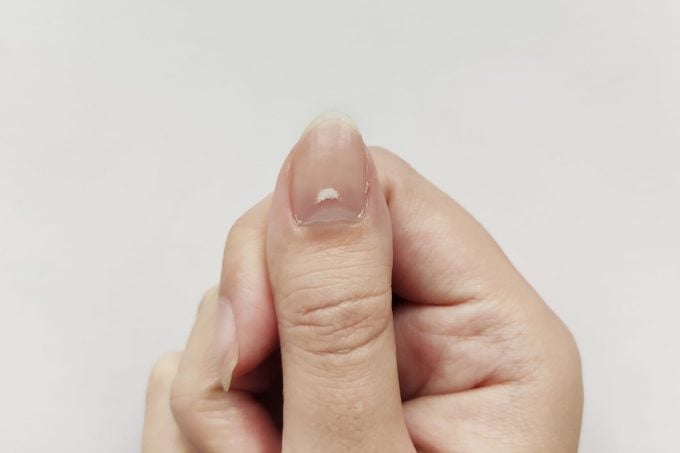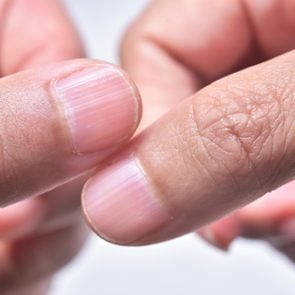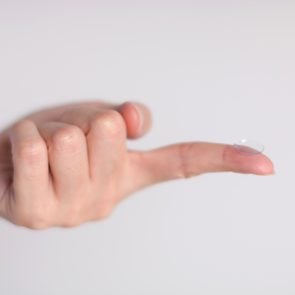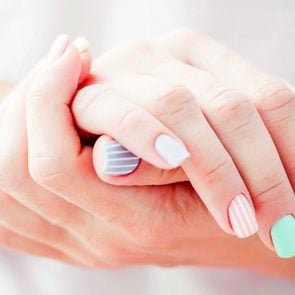Here’s What It Means if You Have White Spots on Your Nails
Updated: Apr. 21, 2021
White spots on your fingernails or toenails, called leukonychia, can have a variety of causes—from simply hitting your nail to more serious problems.
What white spots mean
Spencer Kroll, MD, has a book on his shelf that he used in medical school. In it, there’s information about a once-common practice for doctors.
When they’d shake the patient’s hand upon entering the exam room (pre-Covid days) the doctor would turn the hand slightly to look at the fingernails.
“It was a critical part of diagnosis, from that initial glance at the fingernails,” says Dr. Kroll, an internal medicine specialist in Morganville, New Jersey. “They looked at the color and texture before we had these elaborate tests.”
White spots on fingernails, called leukonychia, can have a variety of causes—from small cosmetic issues to major, life-threatening illnesses. Luckily, it’s rarely the latter. While there are a few types, the most common one is called leukonychia punctata. It’s often seen in children who can be harder on their nails than adults are, says Sunitha Posina, MD, an internist in New York City.
Here are the most common reasons you might have white spots on your fingernails (or toenails).

Trauma to the nail
If you’ve ever hit your nail on something, you may have developed white spots from the trauma to the nail. In addition, you can also have this happen if there’s trauma to “the matrix, the base of where the nail forms,” says Emmanuel Loucas, MD, founder of Lucas Dermatology & Laser Center in New York City.
In this case, the spots may take a while to go away, as nails grow slowly. This type of minor trauma can also result in fingernail ridges rather than white spots.
“Nails grow at a variable rate—they grow more in the wintertime and in colder months,” Dr. Kroll says.
But it can take several months to a year for nails to grow. “So if they were damaged, or there was a clear inciting event…it’s reasonable to track that event and wait several months” if there are no other symptoms, he adds.
Manicures, artificial nails, and other nail treatments
Ever had an amazing manicure, only to realize those artificial tips you had glued on your nail did some damage? This also counts as trauma to the nail, according to Dr. Kroll, and can take a while to grow out.
It’s not just nail tips that are the culprits, but a variety of beauty treatments. “There can be an allergic reaction to something topically on the fingers, from nail lacquers to fake nails to other topical applications,” he says.
Psoriasis or eczema
“Your nails are an extension of your skin, and in actuality, a type of skin,” says Dr. Loucas. So some conditions that can affect your skin can also affect your nails.
Psoriasis and eczema are skin conditions characterized by itching, rashes, and redness. These can manifest in the nails as well as your skin, resulting in nail whitening, says Dr. Loucas.
Psoriasis of the nails can look like thickening and whitening on the nails. It can also look like pitted, white dots, he says. Eczema can cause ridges, discoloration, and thickening. A dermatologist can help you find treatments that work.
Fungus
If you’ve spent some time in your gym’s shower, a swimming pool, or other moist location, you may be experiencing nail fungus, especially on toenails. Fungus, says Dr. Loucas, can look like nail thickening and white coloring. If it’s extensive, then the whiteness and thickening can involve the entire nail.
Fungus is also commonly confused with psoriasis, he says. In order to diagnosis the condition properly, your doctor might take a clipping or scraping from your nails and send it off to a lab to identify if a fungus is causing an infection. Oral, topical, laser, and surgical treatments can help treat a nail fungus problem, depending on the severity. Here are the different types of toenail fungus and how to treat them.
Covid-19
One of the least well-known symptoms of Covid-19 involves your toes and toenails. They’ve been nicknamed “Covid toes,” and can be the only indication someone has Covid-19. Dr. Kroll explains that while this symptom typically involve red toes, sometimes patients might also experience pale nail beds: “It can look whitish and could be seen in fingernails as well,” he says.
The American Academy of Dermatology recommends hydrocortisone cream to relieve symptoms. Patients should keep a close eye on other potentially more dangerous Covid-19 symptoms and follow up with a doctor if they think they need testing or treatment.
This can sometimes happen in relation to vascular problems from Covid-19, which includes blood vessels and circulation, says Dr. Kroll. (Learn more about Covid toes and other unusual symptoms of the disease.)
Vitamin/mineral deficiencies (a hotly debated one)
Your grandmother might have told you that those white spots are because you are calcium deficient, and you need to drink more milk. Doctors and researchers disagree as to whether she’s right or wrong. Some say vitamin and mineral deficiencies can be the cause, while others say this is a myth that has been disproven.
Vitamin D, calcium, and zinc deficiencies may be the problem, says Dr. Kroll, adding that the United States has an “epidemic of vitamin D deficiency,” in general. When he’s working with patients who may have white spots, he sometimes orders a blood test to check for deficiencies, he says. He also listens to the patient’s history thoroughly, paying special attention to their dietary history and nutritional intake. “It’s important to listen for misconceptions,” he says.
Dr. Loucas says there’s been a lot of controversy and literature on both sides of the argument. “In general, calcium and other mineral deficiencies aren’t thought to cause leukonychia,” he says.
More serious conditions
More rarely, white spots can be a sign of a more serious condition, such as an autoimmune disease, heart disease, or kidney failure. If you are only having white spots and no other symptoms, Dr. Kroll is much less concerned and suggests simply keeping an eye on the issue.
However, he says if you are having white spots along with other serious symptoms, you should be evaluated immediately. These symptoms include shortness of breath, chest pain, palpitations, and swollen ankles.
Dr. Posina cautions to look for other nail conditions accompanying the white spots. “Nail brittleness, discoloration, ridges, and grooves might be indicative of more systemic changes that need to be thoroughly evaluated,” he says.
A study published in 2016 in the Indian Journal of Dermatology lists many possible diseases associated with leukonychia. Those include: HIV, liver cirrhosis, Kawasaki disease (an illness that causes inflammation in blood vessels), arsenic or lead poisoning, renal failure, and liver failure. Leukonychia can also follow an acute illness.
Medication side effects
White spots on your nails can be one of the lesser-known side effects of some medications. Dr. Posina lists common culprits, but you should tell your doctor about all side effects from medications:
-
Sulfur drugs like some antibiotics used to treat skin infections and other bacterial infections (for example: Bactrim, Dapsone)
-
Water pills like furosemide (Lasix) and hydrochlorothiazide (Microzide)
-
Arthritis pain medication like celecoxib (Celebrex)
-
Diabetes medications such as glimepiride (Amaryl) and glyburide
-
Sulfasalazine used to treat Crohn’s disease, ulcerative colitis, and rheumatoid arthritis
-
Some chemotherapy drugs
The bottom line
While leukonychia may be unsightly, or may cause you to worry if you have a bigger problem, it’s nothing to worry about most of the time. Usually it’s just from bumping your nail on the corner of that kitchen island one too many times. To rule out more serious conditions, don’t hesitate to discuss your nail health with your doctor.




